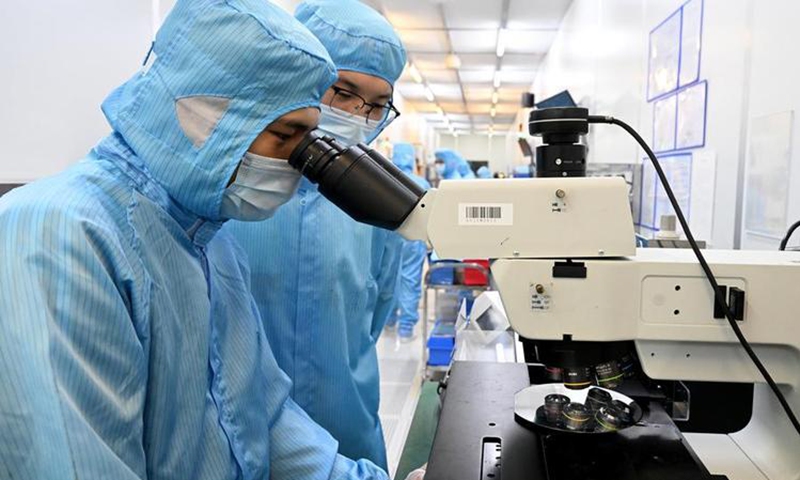"Lab Assistant": AI enhancing scientific research with speed, precision

As scientists are striving to develop AI products and solutions to enhance various industries and daily life, this booming technology is also serving as a "lab assistant," contributing to scientific progress in turn.
In China, AI has been increasingly integrated into diverse research fields, particularly in life sciences, drug discovery and environmental studies. It shows substantial potential to boost efficiency, transform approaches and expedite breakthroughs.
OFFERING EARLY DISEASE DETECTION
Researchers from Shanghai-based Fudan University have made a technological breakthrough in early disease detection. With the assistance of AI, this advancement enables doctors to diagnose and predict diseases simply through a blood test.
Targeted at Alzheimer's disease, the research team used big data and an AI algorithm to screen 1,500 plasma proteins and identified 11 that are capable of predicting dementia risks.
"Through blood tests, we identified that these proteins exhibited consistent changes. With the help of AI-based calculations for disease markers, we were able to detect Alzheimer's disease at least 15 years before diagnosis," lead researcher Yu Jintai said.
"These changes are not caused by genetic modifications but rather due to differences in protein expression," Yu explained. "Much like how a caterpillar transforms into a butterfly."
The study soon garnered attention within the global medical community after being featured in the journal Nature in late 2024. Rather than resting on their laurels, the research team continued their experimental efforts, endeavoring to uncover more relationships between diseases and proteins with the AI tool.
Following an analysis of over 50,000 blood samples and health data collected during a 14-year follow-up study, the team created the world's first atlas of plasma proteins in health and disease states, which can help forecast diabetes and heart disease risks a decade in advance.
Researchers are currently developing a low-cost detection kit, priced under 100 yuan (14 U.S. dollars) to make protein testing as routine as glucose checks.
SLASHING DRUG DEVELOPMENT TIMELINES
At Hangzhou-based Liangzhu Laboratory, a research team has invented an AI algorithm to reduce the development process of a drug for treating progeria, a rare pediatric disease.
The traditional large-scale screening method for small-molecule drug development takes 15 to 20 years, with a high failure rate. However, the AI algorithm can reduce the cycle to approximately 3 to 5 years, accelerating preclinical trials that previously consumed 90 percent of the research time, according to Shen Ning, a researcher in the lab and a member of the program.
Under Zhejiang University, the laboratory in 2021 established a multidisciplinary research team of experts in clinical medicine, bioscience, mathematics, computing and statistics. They have developed several advanced AI algorithms specifically designed for the precise diagnosis of genetic and rare diseases.
China's National Health Commission and other departments jointly issued the guidelines for 84 AI application scenarios in the health sector, including drug research and development.
For decades, the pharmaceutical industry has been confronted with a "double-10" challenge: it usually requires 10 years and an investment of 1 billion U.S. dollars to develop a new drug. Many people believe that AI will be the most promising solution to overcome the long-standing dilemma.
"AI has the potential to impact the entire chain of drug development," said Academician Chen Kaixian of the Chinese Academy of Sciences (CAS).
While no AI-assisted drug development has reached markets yet, multiple candidates are advancing through clinical trials in China.
DECODING CLIMATE CHANGE IMPACTS
In March, CAS researchers and tech company Alibaba Cloud collaboratively unveiled "Luoshu," an AI model that can precisely trace water origins and predict runoff volumes in the Qinghai-Tibet Plateau, which is known as the Asian Water Tower, home to headwaters of over 10 major Asian rivers.
Warming at twice the global average over the past 50 years, the plateau is experiencing an imbalance in its water systems among glaciers, lakes and rivers. This imbalance is expected to exacerbate uncertainties in water supply, energy supply and demand, as well as food production, according to Xia Cuihui, a participant and an associate researcher at the CAS's Institute of Tibetan Plateau Research.
Hydropower generation capacity in glacier regions has declined globally in recent years. Although the reasons remain unclear, it is most likely associated with climate change, the researcher told Xinhua.
The new AI model can help predict water flow for hydropower plants by tracking where the water comes from -- like rain, melting glaciers, or underground water. "If something unusual happens, such as glaciers melting too fast or a bad drought, it will automatically update the water supply predictions," Xia explained.
Compared with conventional approaches, the AI model enhances prediction accuracy by 20 percent and can monitor real-time source contributions. It can alert power grids to prepare for short-term emergencies while providing scientific support for long-term decision-making in clean energy generation.
"Luoshu" is one of the numerous AI models recently launched by the CAS. Several institutes within the country's highest natural sciences academic organization have launched AI tools based on Alibaba's reasoning model, covering applications from astronomical observation to coral species identification.
For researchers like Xia, who holds a Ph.D. in geography, AI has already become an essential tool in the lab, but it is not just about efficiency.
"It unlocks research once deemed impossible," the female scientist added, noting that many research ideas previously limited by traditional methods can now be realized with AI support, promoting greater innovation.